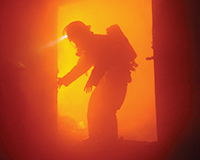Last year, Nick Robertson, founder and chief executive of online fashion retailer Asos, said his ‘baby’ was on target to become a £1bn business by 2015. But on the night of Friday 20 June, his dream turned to ash.
The fire had been started deliberately. By the time the 10 fire engines and 60 firefighters got the blaze under control, it had burned at temperatures of more than 1,000°C and ripped through several floors of Asos’s main distribution warehouse at Prologis Barnsley. One-fifth of the retailer’s stock was destroyed. As well as garments directly damaged by the fire and smoke, many more were drenched by fire-hoses and sprinklers.
The total damage was put at £22m. But it didn’t end there. Forced to suspend trading and with uncertainty rife, Asos’s share price dropped by 3%. Last month, analysts at JP Morgan said this cost the company a further £30m, adding to a share-price slump of 42% earlier in the month after Asos cut its profit margins.
After a rocky year, during which nearly 65% had been drained from its listed value, the fire at Barnsley could have been the final straw for Asos.
Instead, the retailer rallied. Within weeks of the fire, rumours of a takeover bid had pushed up its share prices, sales volumes had increased and Robertson began to talk about expansion again.
More importantly, Asos was able to return to ‘business as usual’ at Barnsley just two days after the fire.
For Maurice Dalton, senior vice-president for construction and procurement at Prologis UK, which built the Asos shed, that is a great result.
“There was limited damage to the building,” says Dalton. “It was still complete, still standing. The roof remained intact. That is a testament to the design and the safety of the building.”
Prologis doesn’t own the Asos building any more, but it is on its ‘campus’, and its supply chain has been back into the building to help with repairs.
When Asos took the lease on the 600,000 sq ft Barnsley shed in 2010, it was brand new, with BREEAM ‘Excellent’ and EPC ‘A’ ratings. Prologis arranged a full fit-out, including sprinklers, so that Asos could move straight in from its Hemel Hempstead warehouse, which was now too small for its growing requirements.
Incidentally, the Hemel Hempstead shed was also damaged during Asos’s tenure, in 2005 when explosions ripped through the Buncefield fuel depot.
Worst fate
At that time, Robertson said it was the worst fate an online retailer could suffer, with the company forced to suspend its shares and refund about 19,000 orders.
Nine years on, and its fate could have been far worse. According to a report by the Centre for Economics and Business Research published in January, warehouse fires cost the British economy £230m a year. Over five years, that amounts to more than £1bn, along with some 5,000 jobs lost.
Most of these fires are devastating because the buildings do not have sprinkler systems, says the report. Without a sprinkler system in place, Asos’s Barnsley shed would have burnt to the ground (see box right).
For many warehouses, a sprinkler system is not required by law. Building regulations insist that structures of more than 40,000m³ require sprinklers, but below that size, it is up to you.
Fortunately, insurers demand rather higher standards. “A building may be compliant with statutory standards, which focuses on protecting lives,” says James Bent, partner at property and construction consultancy Tuffin Ferraby Taylor. “But it may fail to reach the standards set by insurers, which add a further requirement for stock protection. As a result, insurers often set higher fire safety standards compared to the statutory standards.”
For James Lane, head of fire engineering at Capita, this is a vital point. “Building regs are about life safety,” he says. “They have nothing to do with protecting the property or the stock. As long as you can demonstrate that everyone can get out, building regulations don’t care if it burns to the ground.”
But the opposite is true for insurers. “They are all about the property protection,” says Lane.
As such, insurers tend to insist on sprinklers and vents in all but a few exceptional circumstances.
“Many people worry about water damage caused by sprinklers,” says Lane. “But not putting in a sprinkler system won’t stop water damage. The fire brigade will spray hoses everywhere and the flow rate is many times higher than a sprinkler.”
What the Barnsley fire also draws attention to is just how ‘at risk’ companies like Asos are.
Modern retailing requires nodes, hubs and central distribution points. In other words, it puts all its eggs into one basket.
Every item sold by Asos passes through that warehouse before it is shipped. More than 70% of Asos’s total supply was in that warehouse on Friday 20 June, and an uncontrollable fire would have killed the business.
There are some impressively high-tech fire prevention, detection and suppression systems on the market.
DuPont’s FM200, for instance, uses a gas that sucks the heat out of a fire but doesn’t drench everything. As a result, it is a favourite for data centres and document storage, allowing the fire to be stifled and suppressed without the danger of water damage.
It would be perfect for a business such as Asos, but sadly it simply would not work in an open-plan, 600,000 sq ft warehouse.
Another favourite for document storage is a sealed system, which reduces the oxygen in the building to below 19%. This slight atmospheric reduction is enough to ensure that any fire, once started, will swiftly be starved of oxygen and will fail to take hold.
But not only is such a system impossible to maintain in a large warehouse, what starves the fire will also suffocate staff. After a few hours with depleted oxygen levels, most personnel would faint or vomit.
Until a new technology suitable for large-scale spaces is developed, sprinklers are pretty much the cutting-edge option, indeed the only one.
But despite the lack of options, many developers are keen to ensure that everything they build is as fire-resistant as possible. SEGRO, for example, has comprehensive fire prevention measures across its estate.
Similarly Prologis is committed to using only the best materials in buildings and fitting out to the highest fire-resistant standards. “As far as I am aware, there has never been a conversation about compromising on that,” says Dalton. “If a new product or system is developed within our supply line, or even outside of it, that makes our buildings safer and better equipped to cope with these sorts of eventuality, then we would not hesitate to use it in our developments.”
Dalton points out that the Asos fire was the first one in any of its buildings for at least five years.
But, infrequent though fires may be, there is ultimately nothing an organisation can do to guarantee a fire will not threaten its business. “It looks as though the fire at Asos was arson,” says Lane. “And if somebody wants to start a fire, there is not a lot you can do to stop them.”
Although Asos may have recovered rapidly from the fire at its warehouse, the timing could not have been worse. This month, it issued a further profits warning, sending shares tumbling to just £22 from a high of £70 in February. This was always going to be a tough year for the retailer, as its first-mover advantage faded and rivals caught up with its online market share. As one competitor puts it, the Barnsley inferno was “just fuel for the fire”.
Fire protection measures
When you break it down, there are basically three methods used to protect a building and its contents – including people – from fire.
Firstly, there is passive protection. This can be done in a number of ways using flame-retardant materials, but the most effective method is to chop your beautiful big shed into smaller, bite-sized bits.
By dividing a large warehouse into smaller compartments, the fire can be contained, greatly limiting the damage it can cause and enabling firefighting operations to be more focused, which reduces the likelihood of the rest of the goods being hosed.
The only problem is that this is not very useful operationally. What use is a warehouse that a forklift can’t move through? For the newer pick’n’pack mega-sheds favoured by retailers, this is a non-starter because they require uninterrupted routes to function.
Secondly, there are sprinklers, and thirdly, there is smoke venting.
These may be costly, but they can also be highly effective. For instance, if Asos had not had a state-of-the-art sprinkler system in its Barnsley shed, the damage would have been far worse.
But if you are storing goods that are in any way water-sensitive, sprinkler systems pose a big problem. “It isn’t that they leak or drip,” says James Lane, head of fire engineering at Capita. “And if you have to use them, it is probably better that everything gets wet than everything burns.”
No – the problem is condensation. “I did a project for a food distribution warehouse,” says Lane. “Its insurers wanted smoke vents and sprinklers, but the client didn’t want them.
“The reason was that sprinklers condense. And if condensation drips on to salads or whatever, they have to write them off.”
Similarly with smoke vents. They may limit the spread of smoke and help to dampen fires, but they don’t have the same thermal insulation properties, so the building is compromised.
And compromise is what that means for occupiers. If you decide not to chop up your big shed, or fit water sprinklers and thermal vents, then the fire brigade may take the opinion that your building is not safe enough for it to work in.
“In such a case, the fire brigade said that the likelihood was that the fire ?would get out of hand, and they would just have to let the building burn down,” warns Lane.
“They won’t commit people to a dangerous situation to save fruit and veg, or clothes, or even a building. They will just let it burn.”











